
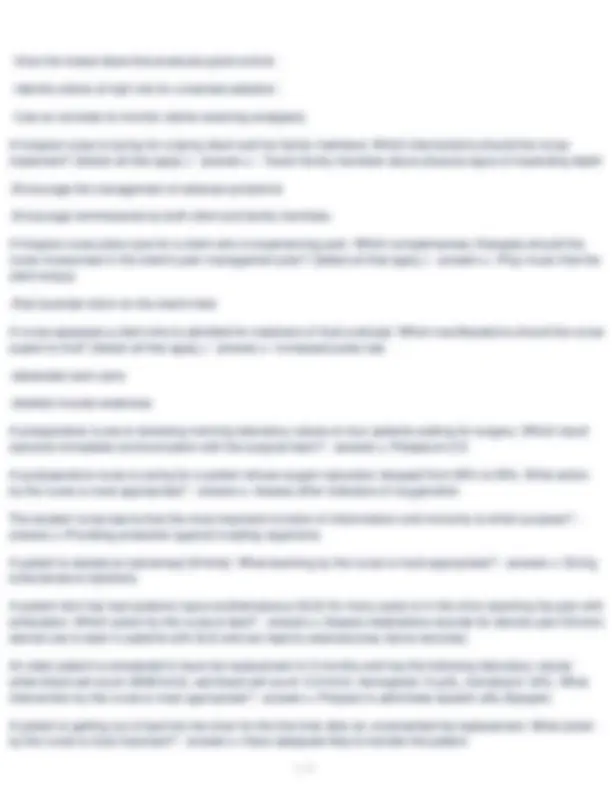
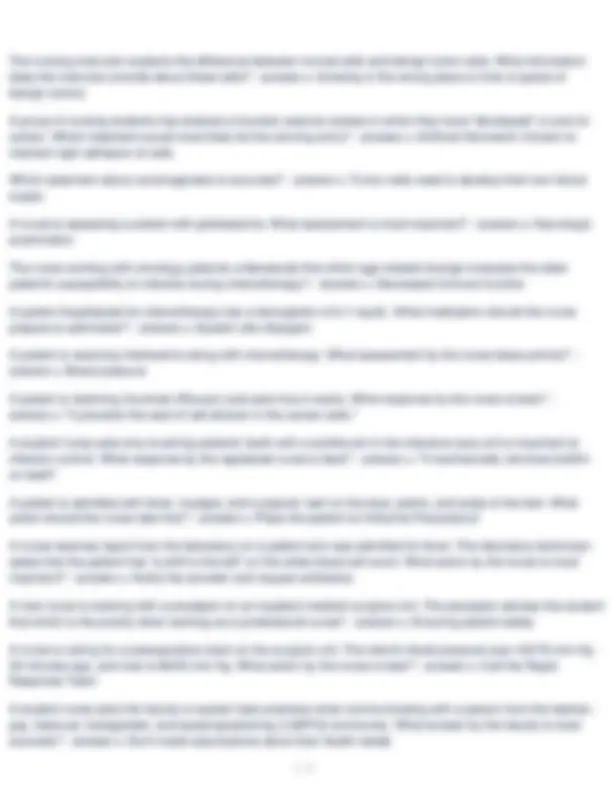
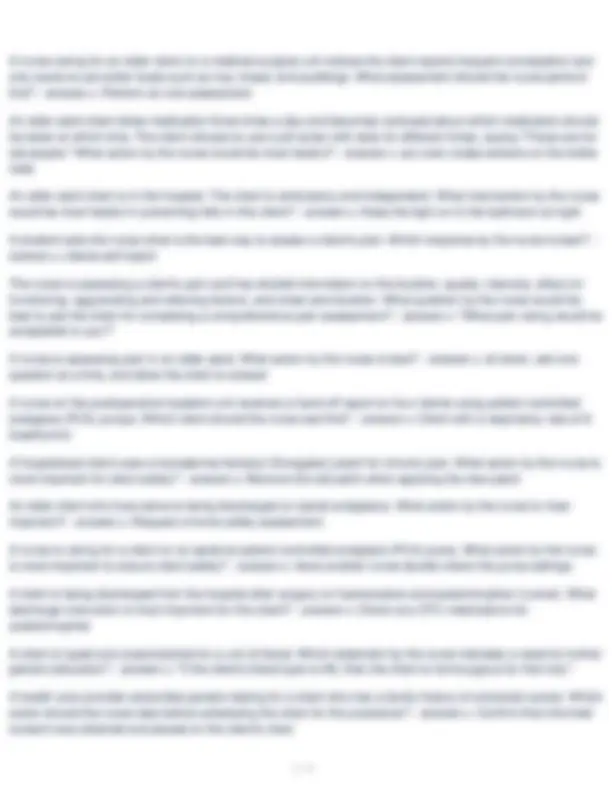
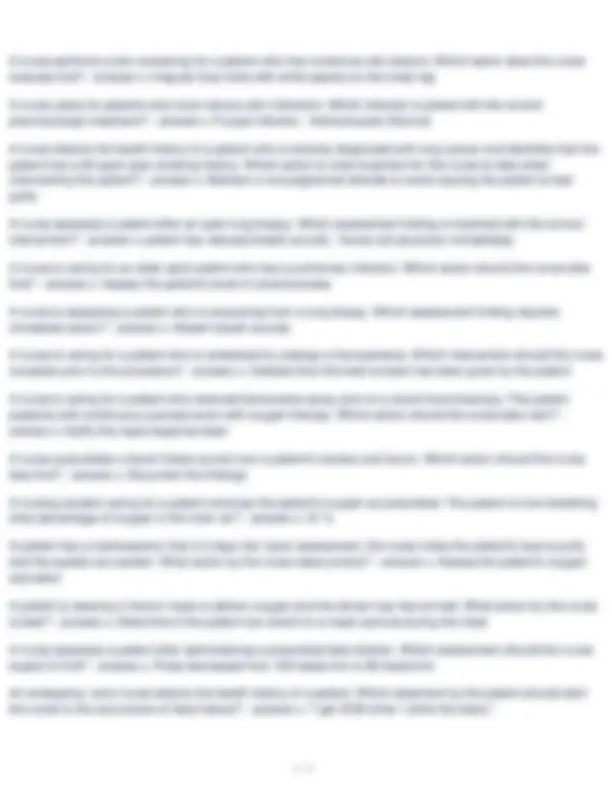

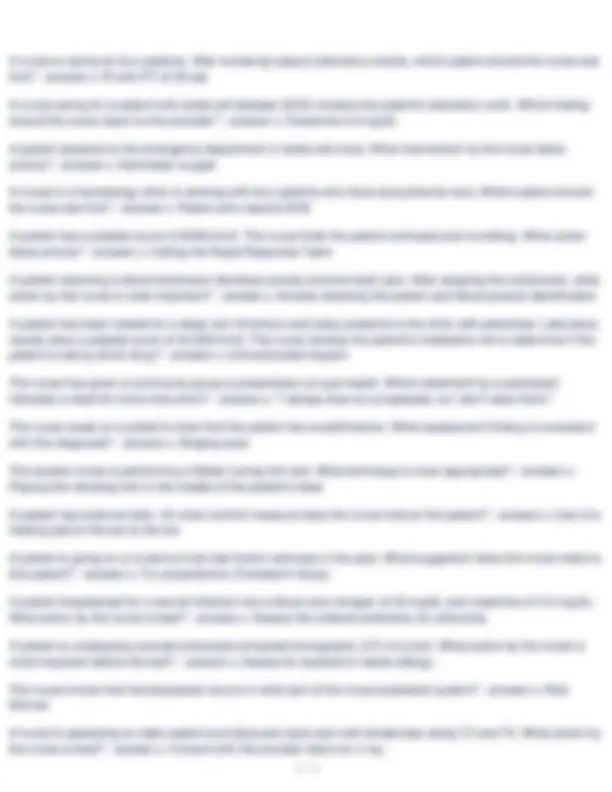
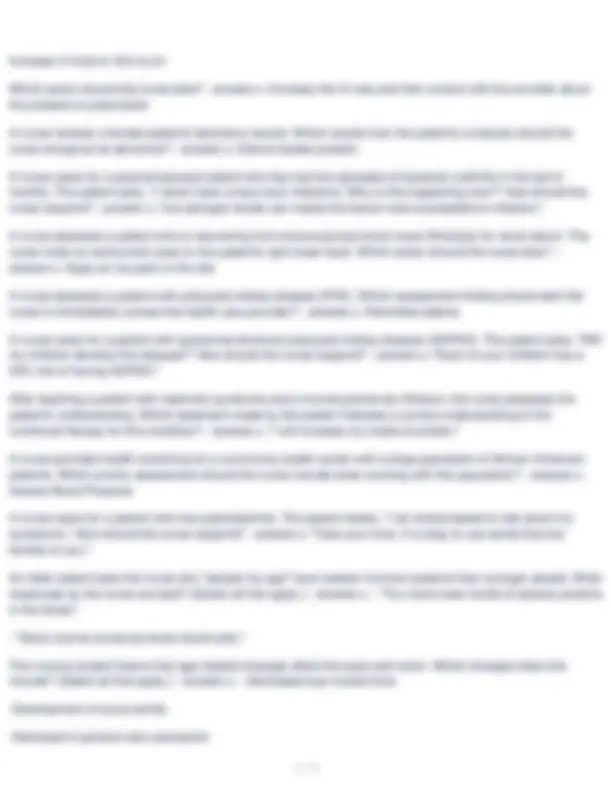
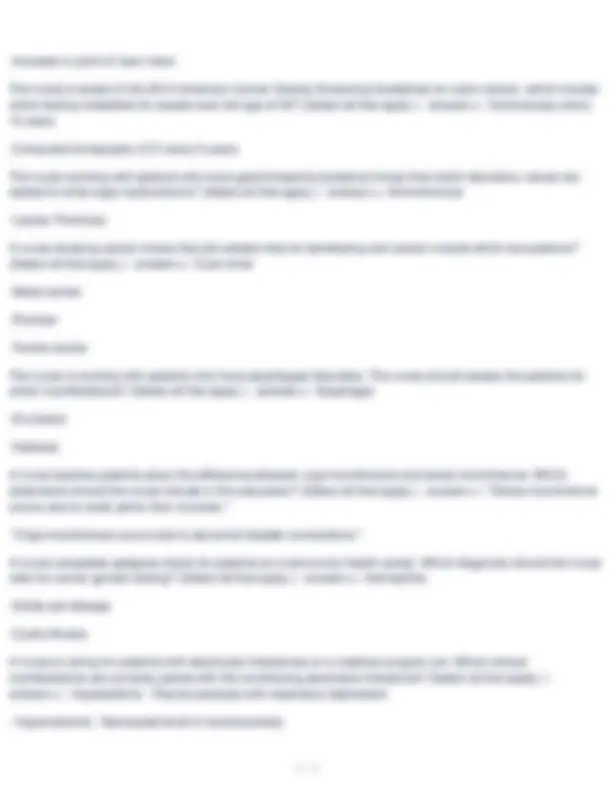
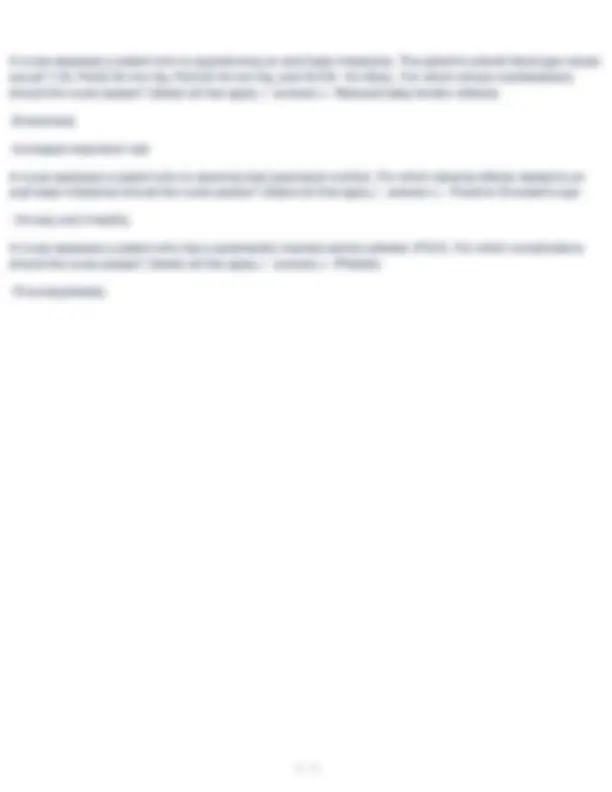


Study with the several resources on Docsity

Earn points by helping other students or get them with a premium plan


Prepare for your exams
Study with the several resources on Docsity

Earn points to download
Earn points by helping other students or get them with a premium plan
Community
Ask the community for help and clear up your study doubts
Discover the best universities in your country according to Docsity users
Free resources
Download our free guides on studying techniques, anxiety management strategies, and thesis advice from Docsity tutors
A wide range of nursing assessments and interventions for various patient conditions, including fall prevention, hyperventilation, intravenous medication administration, infection control, pain management, respiratory issues, cardiac conditions, diabetes management, renal disorders, and gastrointestinal problems. Detailed information on nursing actions and patient education to ensure proper care and safety. It covers topics such as identifying high-risk patients, monitoring vital signs, administering medications, managing symptoms, and educating patients on self-care. The comprehensive nature of the document makes it a valuable resource for nursing students and professionals to enhance their clinical knowledge and decision-making skills.
Typology: Exams
1 / 15

This page cannot be seen from the preview
Don't miss anything!










A nurse assesses a client with diabetes mellitus who is admitted with an acid-base imbalance. The client's arterial blood gas values are pH 7.36, PaO2 98 mm Hg, PaCO2 33 mm Hg, and HCO3- 18 mEq/L. Which manifestation should the nurse identify as an example of the client's compensation mechanism? - answer>> Increased rate and depth of respirations A nurse assesses a client who is experiencing an acid-base imbalance. The client's arterial blood gas values are pH 7.34, PaO2 88 mm Hg, PaCO2 38 mm Hg, and HCO3- 19 mEq/L. Which assessment should the nurse perform first? - answer>> Cardiac rate and rhythm A nurse is caring for a client who is experiencing moderate metabolic alkalosis. Which action should the nurse take? - answer>> Teach the client fall prevention measures A nurse is planning care for a client who is hyperventilating. The client's arterial blood gas values are pH 7.30, PaO2 94 mm Hg, PaCO2 31 mm Hg, and HCO3- 26 mEq/L. Which question should the nurse ask when developing this client's plan of care? - answer>> "You appear anxious. What is causing your distress?" A nurse is caring for a client who has chronic emphysema and is receiving oxygen therapy at 6 L/min via nasal cannula. The following clinical data are available: Arterial Blood Gases Vital Signs pH = 7.28 Pulse rate = 96 beats/min PaO2 = 85 mm Hg Blood pressure = 135/ PaCO2 = 55 mm Hg Respiratory rate = 6 breaths/min HCO3- = 26 mEq/L O2 saturation = 88% Which action should the nurse take first? - answer>> Notify the Rapid Response Team and provide ventilation support A nurse is caring for a client who has just had a central venous access line inserted. Which action should the nurse take next? - answer>> Ensure an x-ray is completed to confirm placement. A nurse assesses a client who has a radial artery catheter. Which assessment should the nurse complete first?
A nurse is caring for a client who is having a subclavian central venous catheter inserted. The client begins to report chest pain and difficulty breathing. After administering oxygen, which action should the nurse take next? - answer>> Prepare to assist with chest tube insertion. A nurse is caring for a client who is receiving an epidural infusion for pain management. Which assessment finding requires immediate intervention from the nurse? - answer>> Report of headache and stiff neck. A nurse is caring for a client with a peripheral vascular access device who is experiencing pain, redness, and swelling at the site. After removing the device, which action should the nurse take to relieve pain? - answer>> Place warm compresses to the site A home care nurse prepares to administer intravenous medication to a client. The nurse assesses the site and reviews the client's chart prior to administering the medication: Client: Thomas Jackson DOB: 5/3/ Gender: Male January 23 (Today): Right upper extremity PICC is intact, patent, and has a good blood return. Site clean and free from manifestations of infiltration, irritation, and infection. - Sue Franks, RN January 20: Purulent drainage from sacral wound. Wound cleansed and dressing changed. Dr. Smith notified and updated on client status. New orders received for intravenous antibiotics. - Sue Franks, RN January 13: Client alert and oriented. Sacral wound dressing changed. - Sue Franks, RN January 6: Right upper extremity PICC inserted. No complications. Discharged with home health care. - Dr. Smith Based on the information provided, which action should the nurse take? - answer>> Administer the prescribed medication A hospitalized older adult has been assessed at high risk for skin breakdown. Which actions does the registered nurse (RN) delegate to the unlicensed assistive personnel (UAP)? (Select all that apply.) - answer>> - Keep the client's skin dry
The nursing instructor explains the difference between normal cells and benign tumor cells. What information does the instructor provide about these cells? - answer>> Growing in the wrong place or time is typical of benign tumors A group of nursing students has entered a futuristic science contest in which they have "developed" a cure for cancer. Which treatment would most likely be the winning entry? - answer>> Artificial fibronectin infusion to maintain tight adhesion of cells Which statement about carcinogenesis is accurate? - answer>> Tumor cells need to develop their own blood supply A nurse is assessing a patient with glioblastoma. What assessment is most important? - answer>> Neurologic examination The nurse working with oncology patients understands that which age-related change increases the older patient's susceptibility to infection during chemotherapy? - answer>> Decreased immune function A patient hospitalized for chemotherapy has a hemoglobin of 6.1 mg/dL. What medication should the nurse prepare to administer? - answer>> Epoetin alfa (Epogen) A patient is receiving interleukins along with chemotherapy. What assessment by the nurse takes priority? - answer>> Blood pressure A patient is receiving rituximab (Rituxan) and asks how it works. What response by the nurse is best? - answer>> "It prevents the start of cell division in the cancer cells." A student nurse asks why brushing patients' teeth with a toothbrush in the intensive care unit is important to infection control. What response by the registered nurse is best? - answer>> "It mechanically removes biofilm on teeth" A patient is admitted with fever, myalgia, and a papular rash on the face, palms, and soles of the feet. What action should the nurse take first? - answer>> Place the patient on Airborne Precautions" A nurse receives report from the laboratory on a patient who was admitted for fever. The laboratory technician states that the patient has "a shift to the left" on the white blood cell count. What action by the nurse is most important? - answer>> Notify the provider and request antibiotics A new nurse is working with a preceptor on an inpatient medical-surgical unit. The preceptor advises the student that which is the priority when working as a professional nurse? - answer>> Ensuring patient safety A nurse is caring for a postoperative client on the surgical unit. The client's blood pressure was 142/76 mm Hg 30 minutes ago, and now is 88/50 mm Hg. What action by the nurse is best? - answer>> Call the Rapid Response Team A student nurse asks the faculty to explain best practices when communicating with a person from the lesbian, gay, bisexual, transgender, and queer/questioning (LGBTQ) community. What answer by the faculty is most accurate? - answer>> Don't make assumptions about their health needs
A nurse caring for an older client on a medical-surgical unit notices the client reports frequent constipation and only wants to eat softer foods such as rice, bread, and puddings. What assessment should the nurse perform first? - answer>> Perform an oral assessment An older adult client takes medication three times a day and becomes confused about which medication should be taken at which time. The client refuses to use a pill sorter with slots for different times, saying "Those are for old people." What action by the nurse would be most helpful? - answer>> put color-codes stickers on the bottle caps An older adult client is in the hospital. The client is ambulatory and independent. What intervention by the nurse would be most helpful in preventing falls in this client? - answer>> Keep the light on in the bathroom at night A student asks the nurse what is the best way to assess a client's pain. Which response by the nurse is best? - answer>> clients self-report The nurse is assessing a client's pain and has elicited information on the location, quality, intensity, effect on functioning, aggravating and relieving factors, and onset and duration. What question by the nurse would be best to ask the client for completing a comprehensive pain assessment? - answer>> "What pain rating would be acceptable to you?" A nurse is assessing pain in an older adult. What action by the nurse is best? - answer>> sit down, ask one question at a time, and allow the client to answer A nurse on the postoperative inpatient unit receives a hand-off report on four clients using patient-controlled analgesia (PCA) pumps. Which client should the nurse see first? - answer>> Client with a respiratory rate of 8 breaths/min A hospitalized client uses a transdermal fentanyl (Duragesic) patch for chronic pain. What action by the nurse is most important for client safety? - answer>> Remove the old patch when applying the new patch An older client who lives alone is being discharged on opioid analgesics. What action by the nurse is most important? - answer>> Request a home safety assessment A nurse is caring for a client on an epidural patient-controlled analgesia (PCA) pump. What action by the nurse is most important to ensure client safety? - answer>> Have another nurse double-check the pump settings A client is being discharged from the hospital after surgery on hydrocodone and acetaminophen (Lorcet). What discharge instruction is most important for this client? - answer>> Check any OTC medications for acetaminophen A client is typed and crossmatched for a unit of blood. Which statement by the nurse indicates a need for further genetic education? - answer>> "If the client's blood type is AB, then the client is homozygous for that trait." A health care provider prescribes genetic testing for a client who has a family history of colorectal cancer. Which action should the nurse take before scheduling the client for the procedure? - answer>> Confirm that informed consent was obtained and placed on the client's chart
A nurse teaches a client who is at risk for mild hypernatremia. Which statement should the nurse include in this client's teaching? - answer>> "Read food labels to determine sodium content" A nurse is assessing clients on a medical-surgical unit. Which client is at risk for hypokalemia? - answer>> Client with pancreatitis who has continuous nasogastric suctioning A client at risk for developing hyperkalemia states, "I love fruit and usually eat it every day, but now I can't because of my high potassium level." How should the nurse respond? - answer>> "Berries, cherries, apples, and peaches are low in potassium." A nurse is caring for a client who has a serum calcium level of 14 mg/dL. Which provider order should the nurse implement first? - answer>> Connect the client to a cardiac monitor A patient has been admitted to the hospital for a virulent infection and is started on antibiotics. The patient has laboratory work pending to determine if the diagnosis is meningitis. After starting the antibiotics, what action by the nurse is best? - answer>> Assess the patient frequently for worsening of his or her condition While assessing a patient, a nurse detects a bluish tinge to the patient's palms, soles, and mucous membranes. Which action should the nurse take next? - answer>> Use pulse oximetry to assess the patient's oxygen saturation A nurse assesses a patient who has multiple areas of ecchymosis on both arms. Which question should the nurse ask first? - answer>> "What medications are you taking?" While assessing a patient's lower extremities, a nurse notices that one leg is pale and cooler to the touch. Which assessment should the nurse perform next? - answer>> Palpate the patient's pedal pulses bilaterally A nurse assesses a patient who has open lesions. Which action should the nurse take first? - answer>> Put on gloves A nurse assesses a patient and identifies that the patient has pallor conjunctivae. Which focused assessment should the nurse complete next? - answer>> Hemoglobin and hematocrit During skin inspection of a patient, a nurse observes lesions with wavy borders that are widespread across the patient's chest. Which descriptors should the nurse use to document these observations? - answer>> Linear and circinate A nurse is caring for a patient who has a pressure ulcer on the right ankle. Which action should the nurse take first? - answer>> Assess the right leg for pulses, skin color, and temperature After teaching a patient who is at risk for the formation of pressure ulcers, a nurse assesses the patient's understanding. Which dietary choice by the patient indicates a good understanding of the teaching? - answer>> High-protein diet with vitamins and mineral supplements A nurse assesses an older patient who is scratching and rubbing white ridges on the skin between the fingers and on the wrists. Which action should the nurse take? - answer>> Place the patient in a single room
A nurse performs a skin screening for a patient who has numerous skin lesions. Which lesion does the nurse evaluate first? - answer>> Irregular blue mole with white specks on the lower leg A nurse cares for patients who have various skin infections. Which infection is paired with the correct pharmacologic treatment? - answer>> Fungal infection - Ketoconazole (Nizoral) A nurse obtains the health history of a patient who is recently diagnosed with lung cancer and identifies that the patient has a 60-pack-year smoking history. Which action is most important for the nurse to take when interviewing this patient? - answer>> Maintain a nonjudgmental attitude to avoid causing the patient to feel guilty A nurse assesses a patient after an open lung biopsy. Which assessment finding is matched with the correct intervention? - answer>> patient has reduced breath sounds - Nurse call physician immediately A nurse is caring for an older adult patient who has a pulmonary infection. Which action should the nurse take first? - answer>> Assess the patient's level of consciousness A nurse is assessing a patient who is recovering from a lung biopsy. Which assessment finding requires immediate action? - answer>> Absent breath sounds A nurse is caring for a patient who is scheduled to undergo a thoracentesis. Which intervention should the nurse complete prior to the procedure? - answer>> Validate that informed consent has been given by the patient A nurse is caring for a patient who received benzocaine spray prior to a recent bronchoscopy. The patient presents with continuous cyanosis even with oxygen therapy. Which action should the nurse take next? - answer>> Notify the rapid response team A nurse auscultates a harsh hollow sound over a patient's trachea and larynx. Which action should the nurse take first? - answer>> Document the findings A nursing student caring for a patient removes the patient's oxygen as prescribed. The patient is now breathing what percentage of oxygen in the room air? - answer>> 21 % A patient has a tracheostomy that is 3 days old. Upon assessment, the nurse notes the patient's face is puffy and the eyelids are swollen. What action by the nurse takes priority? - answer>> Assess the patient's oxygen saturation A patient is wearing a Venturi mask to deliver oxygen and the dinner tray has arrived. What action by the nurse is best? - answer>> Determine if the patient can switch to a nasal cannula during the meal A nurse assesses a patient after administering a prescribed beta blocker. Which assessment should the nurse expect to find? - answer>> Pulse decreased from 100 beats/min to 80 beats/min An emergency room nurse obtains the health history of a patient. Which statement by the patient should alert the nurse to the occurrence of heart failure? - answer>> "I get SOB when I climb the stairs."
A nurse is caring for four patients. After reviewing today's laboratory results, which patient should the nurse see first? - answer>> Pt with PT of 28 sec A nurse caring for a patient with sickle cell disease (SCD) reviews the patient's laboratory work. Which finding should the nurse report to the provider? - answer>> Creatinine 2.9 mg/dL A patient presents to the emergency department in sickle cell crisis. What intervention by the nurse takes priority? - answer>> Administer oxygen A nurse in a hematology clinic is working with four patients who have polycythemia vera. Which patient should the nurse see first? - answer>> Patient who reports SOB A patient has a platelet count of 9000/mm3. The nurse finds the patient confused and mumbling. What action takes priority? - answer>> Calling the Rapid Response Team A patient receiving a blood transfusion develops anxiety and low back pain. After stopping the transfusion, what action by the nurse is most important? - answer>> Double-checking the patient and blood product identification A patient has been treated for a deep vein thrombus and today presents to the clinic with petechiae. Laboratory results show a platelet count of 42,000/mm3. The nurse reviews the patient's medication list to determine if the patient is taking which drug? - answer>> Unfractionated heparin The nurse has given a community group a presentation on eye health. Which statement by a participant indicates a need for more instruction? - answer>> "I always lose my sunglasses, so I don't wear them." The nurse reads on a patient's chart that the patient has exophthalmos. What assessment finding is consistent with this diagnosis? - answer>> Bulging eyes The student nurse is performing a Weber tuning fork test. What technique is most appropriate? - answer>> Placing the vibrating fork in the middle of the patient's head A patient has external otitis. On what comfort measure does the nurse instruct the patient? - answer>> Use of a heating pad to the ear to the ear A patient is going on a cruise but has had motion sickness in the past. What suggestion does the nurse make to this patient? - answer>> Try scopolamine (Transderm Scop). A patient hospitalized for a wound infection has a blood urea nitrogen of 45 mg/dL and creatinine of 4.2 mg/dL. What action by the nurse is best? - answer>> Assess the ordered antibiotics for ototoxicity A patient is undergoing contrast enhanced computed tomography (CT) of a joint. What action by the nurse is most important before the test? - answer>> Assess for seafood or iodine allergy. The nurse knows that hematopoiesis occurs in what part of the musculoskeletal system? - answer>> Red Marrow A nurse is assessing an older patient and discovers back pain with tenderness along T2 and T3. What action by the nurse is best? - answer>> Consult with the provider about an x-ray.
The nurse sees several patients with osteoporosis. For which patient would bisphosphonates not be a good option? - answer>> patient with a spinal cord injury who cannot tolerate sitting up A patient is scheduled for a bone biopsy. What action by the nurse takes priority? - answer>> Ensuring that informed consent is on the chart The student nurse studying the gastrointestinal system understands that chyme refers to what? - answer>> Liquefied food ready for digestion A patient had a colonoscopy and biopsy yesterday and calls the gastrointestinal clinic to report a spot of bright red blood on the toilet paper today. What response by the nurse is best? - answer>> Remind the pt that a small amount of bleeding is possible A nurse is examining a patient reporting right upper quadrant (RUQ) abdominal pain. What technique should the nurse use to assess this patient's abdomen? - answer>> Palpate the RUQ last The nurse knows that a patient with prolonged prothrombin time (PT) values (not related to medication) probably has dysfunction in which organ? - answer>> Liver The nurse reads a patient's chart and sees that the health care provider assessed mucosal erythroplakia. What should the nurse understand that this means for the patient? - answer>> Early sign of oral cancer A patient has returned to the nursing unit after an open Nissen fundoplication. The patient has an indwelling urinary catheter, a nasogastric (NG) tube to low continuous suction, and two IVs. The nurse notes bright red blood in the NG tube. What action should the nurse take first? - answer>> Take a full set of vital signs A patient is scheduled for a traditional esophagogastrostomy. All preoperative teaching has been completed and the patient and family show good understanding. What action by the nurse is best? - answer>> Assess the patient's psycho-social status A patient has a nasogastric (NG) tube after a Nissen fundoplication. The nurse answers the call light and finds the patient vomiting bright red blood with the NG tube lying on the floor. What action should the nurse take first?
Increase IV fluid to 100 mL/hr Which action should the nurse take? - answer>> Increase the IV rate and then consult with the provider about the potassium prescription A nurse reviews a female patient's laboratory results. Which results from the patient's urinalysis should the nurse recognize as abnormal? - answer>> Ketone bodies present A nurse cares for a postmenopausal patient who has had two episodes of bacterial urethritis in the last 6 months. The patient asks, "I never have urinary tract infections. Why is this happening now?" How should the nurse respond? - answer>> "low estrogen levels can makes the tissue more susceptible to infection." A nurse assesses a patient who is recovering from extracorporeal shock wave lithotripsy for renal calculi. The nurse notes an ecchymotic area on the patient's right lower back. Which action should the nurse take? - answer>> Apply an ice pack to the site A nurse assesses a patient with polycystic kidney disease (PKD). Which assessment finding should alert the nurse to immediately contact the health care provider? - answer>> Periorbital edema A nurse cares for a patient with autosomal dominant polycystic kidney disease (ADPKD). The patient asks, "Will my children develop this disease?" How should the nurse respond? - answer>> "Each of your children has a 50% risk of having ADPKD." After teaching a patient with nephrotic syndrome and a normal glomerular filtration, the nurse assesses the patient's understanding. Which statement made by the patient indicates a correct understanding of the nutritional therapy for this condition? - answer>> "I will increase my intake of protein." A nurse provides health screening for a community health center with a large population of African-American patients. Which priority assessment should the nurse include when working with this population? - answer>> Assess Blood Pressure A nurse cares for a patient who has pyelonephritis. The patient states, "I am embarrassed to talk about my symptoms." How should the nurse respond? - answer>> "Take your time. It is okay to use words that are familiar to you." An older patient asks the nurse why "people my age" have weaker immune systems than younger people. What responses by the nurse are best? (Select all that apply.) - answer>> - "You have lower levels of plasma proteins in the blood."